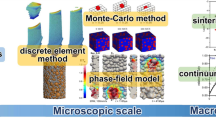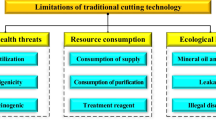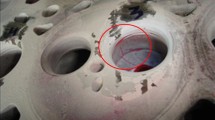Abstract
A mathematical model has been developed to simulate the flow pattern of molten metal and to predict the liquid-gas interface shape in the shot sleeve of a cold chamber die casting machine during the injection stage. The flow pattern in the shot sleeve is known to be closely related to the extent of gas entrapment of molten metal in the sleeve during the injection operation. In this study, a Variable Spacing Even Mesh (VSEM) method is proposed to incorporate with a computational fluid dynamics technique, named SOLA-MAC, to simulate the flow pattern in the shot sleeve. SOLA-MAC can deal with free surface flow problems while the VSEM method is used to handle the problem where the space in the shot sleeve keeps decreasing as the plunger moves to push the molten metal. The model is then tested on the shot sleeve of a cold chamber die casting machine. Four plunger speeds are tested to demonstrate the effects on the flow pattern of molten metal in the shot sleeve. The critical speed found in this study is 38 cm/s and it is close to the reported critical speed under the conditions that the space between the plunger and the sleeve end is 5 cm in diameter and 30 cm in length, and the fill ratio is 50%. As the plunger speed is slower than the critical speed, the wave front propagates along the sleeve faster than the plunger and reflects against the end wall of the sleeve. The remaining air in the shot sleeve is entrained as the wave front enters to the gate. As the plunger speed is higher than the suggested critical speed, the melt is immediately pushed higher in front of the plunger and forms a surge. The surge traps air in the early stage of the injection process.









Similar content being viewed by others
References
F. Faura, J. Lopez, J. Hernandez, On the Optimum Plunger Acceleration Law in the Slow Shot Phase of Pressure Die Casting Machines, Intl J. Machine Tools Manuf. Vol. 41, no. 2, 2001, p 173–191
J.R. Brevick, M. Duran, and Y. Karni, Experimental Determination of Slow Shot Velocity—Position Profile to Minimize Air Entrapment, Transactions of 16th International Die Casting Congress and Exposition, Sept 30-Oct 3, 1991 (Detroit), North American Die Casting Association, 1991, p 399–404
L.W. Garber, Theoretical Analysis and Experimental Observation of Air Entrapment during Cold Chamber Filling, Die Cast. Engineer, Vol. 26, 1982, p 14–22
T.C. Tszeng and Y.L. Chu, A Study of Wave Formation in Shot Sleeve of a Die Casting Machine, The Ohio State University, ERC/NSM-C-92-01, Feb., 1992
M.C. Thome, J.R. Brevick, Modeling Fluid Flow in Horizontal Cold Chamber Diecasting Shot Sleeves, Trans. Am. Foundrymen’s Soc., Vol. 102, 1993, p 343–348
M. Duran, “Minimization of Air Entrapment in the Shot Sleeve of a Die Casting Machine to Reduce Porosity,” Report No. ERC/NSM-C-91-31, The Ohio State University, July, 1991
S. Kashiwai, I. Ohnaka, A. Kimatsuka, T. Kaneyosi, T. Ohomichi, J.D. Zhu, Numerical Simulation and X-ray Direct Observation of Mould Filling During Vacuum Suction Casting, Intl J. Cast Metals Res., Vol. 18, no. 3, 2005, p 144–148
S.H. Jong, W.S. Hwang, 3-D Mold Filling Simulation for Casting and Its Experimental Verification, Trans. Am. Foundrymen’s Soc., Vol. 99, 1991, p 117–124
K. Anzai and T. Uchida, Mold Filling Patterns of Flat Plate Die Castings, M. Rappaz, M.R. Özgü, and K.W. Mahin, Eds., Conference Proceeding on the Modeling of Casting, Welding and Advanced Solidification Processes V, Sept 16–21, 1990, Davos, Switzerland, TMS, 1991, p 741–748
H. Nomura, K. Terashima, K. Keishima, Prediction of Die Casting Flow Behavior by Three Dimensional Simulation, J. Japanese Foundrymen’s Soc., Vol. 63, no. 5, 1991, p 425–430
H.S. Carslaw, J.C. Jaeger, Conduction of Heat in Solids, 2nd ed, Oxford Univ. Press, London, 1959
R.S. Gupta, Moving Grid Method without Interpolations, Comput. Methods Appl. Mech. Eng., Vol. 4, 1974, p 143–152
R.S. Gupta, D. Kumar, A Modified Variable Time Step Method for the One-dimensional Stefan Problem, Comput. Methods Appl. Mech. Eng., Vol. 23, 1980, p 101–109
J.C. Muehlbauer, J.E. Sunderland, Heat Conduction with Freezing or Melting, Appl. Mech. Rev., Vol. 18, 1965, p 951–959
S.G. Bankhoff, Advances in Chemical Engineering, Drew, Hoopes, and Vermeulen, Eds., Academic Press, 1964, p 75–150
J. Douglas, T.M. Gallie, On the Numerical Integration of a Parabolic Differential Equation Subject to a Moving Boundary Condition, Duke Math. J., Vol. 22, 1955, p 557–570
W.D. Murray, F. Landis, Numerical and Machine Solutions of Transient Heat Condition Problems Involving Melting or Freezing, J. Heat Transfer, Vol. 81, 1959, p 106–112
R.S. Gupta, D. Kumar, Complete Numerical Solution of the Oxygen Diffusion Problem Involving a Moving Boundary, Comput. Methods Appl. Mech. Eng., Vol. 29, 1981, p 233–239
Acknowledgments
The authors would like to express their gratitude to the Metal Industries Research and Development Center in Taiwan, R.O.C., for their financial support of this study.
Author information
Authors and Affiliations
Corresponding author
Rights and permissions
About this article
Cite this article
Han, TH., Kuo, JH. & Hwang, WS. Numerical Simulation of the Liquid-Gas Interface Shape in the Shot Sleeve of Cold Chamber Die Casting Machine. J. of Materi Eng and Perform 16, 521–526 (2007). https://doi.org/10.1007/s11665-007-9093-4
Received:
Revised:
Accepted:
Published:
Issue Date:
DOI: https://doi.org/10.1007/s11665-007-9093-4




